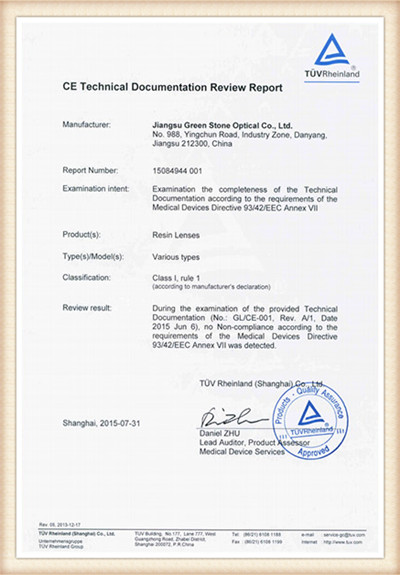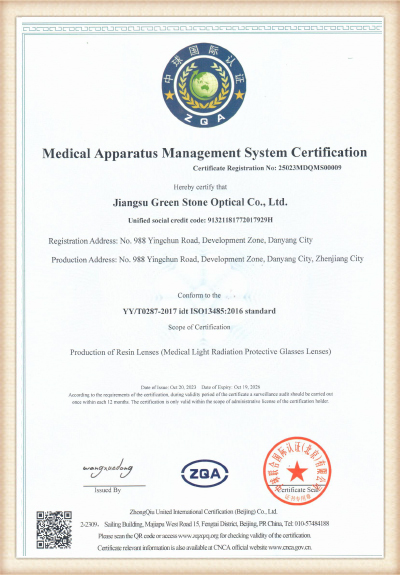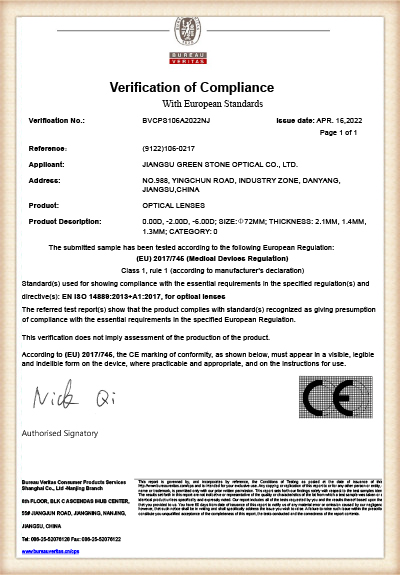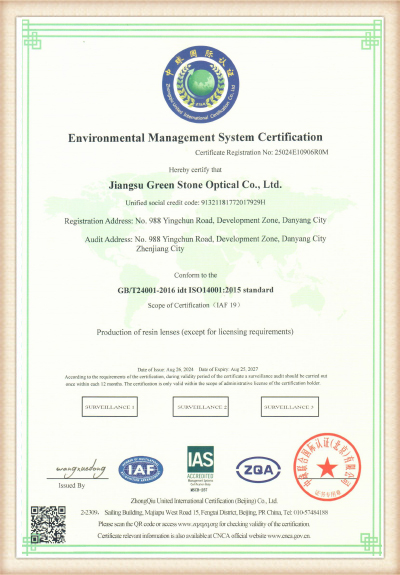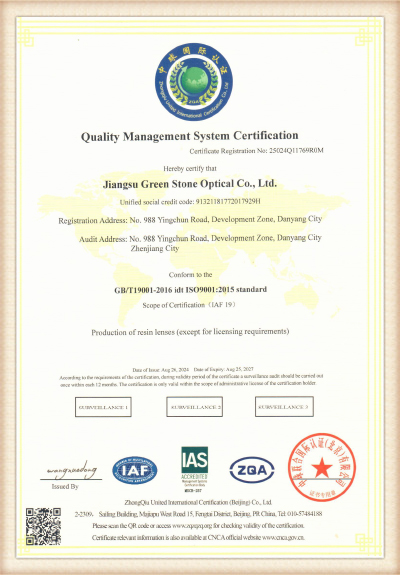Introduction to Core Concepts: The Purpose of Polarized and Photochromic Lenses Advanced lens technologies are designed to enhance visual comfort and protect the eyes from harmful light. Among the many high-quality options, Polarized Lenses and Photochromic Lenses are two of the most popular choices, yet they address d...
READ MORE
Product Series
Bifocal+SV: Lenses Designs Manufacturers
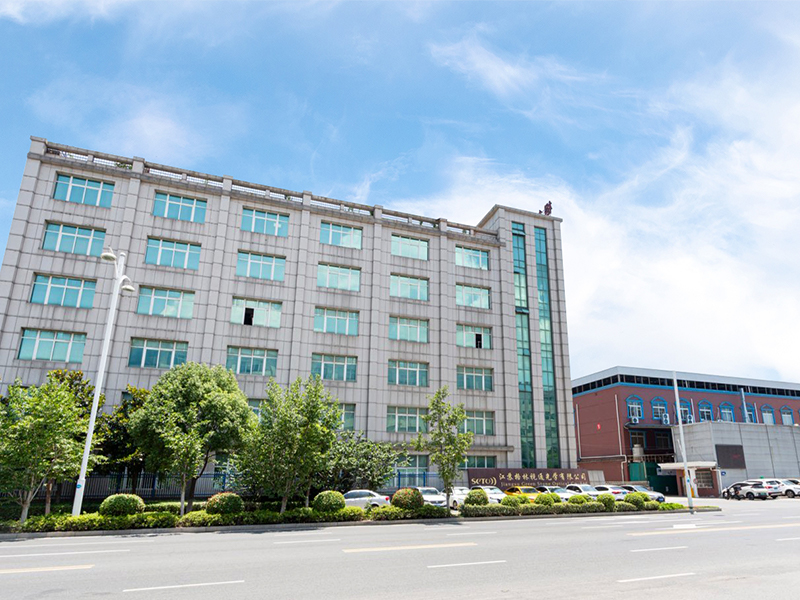
Our lens products involves almost all types of lenses. Product range covers 1.499, 1.56, 1.60, 1.67, 1.70 and 1.74 index, including single vision,bifocal, progressive, blue cut, Photochromic, blue cut photochromic, Infrared cut etc. with HC, HMC and SHMC treatment. Besides finished lens, We also manufactures semi-finished blanks. The products are registered with CE&FDA and our production certified by ISO9001& ISO14001 standards.
We positively introduce excellent management technology, comprehensively import Corporate Identity System and enhance the external image of company and brand.
-
-
Introducing Normal Lenses and Defocus Lenses In the fields of optics and image capture, the lens is a core component responsible for guiding and shaping light to form an image on a sensor or retina. While all lenses are based on the same laws of physics, their design goals and final effects can vary widely. This articl...
READ MORE -
Unveiling the Technology of Bifocal Lenses Introduction to Bifocal Lenses A bifocal lens is a powerful and time-tested solution in vision correction. Simply put, it is a corrective lens that contains two distinct optical powers within a single lens surface. This design addresses a common challenge faced by millions: ne...
READ MORE
What are the key optical design differences between bifocal and single vision (SV) lenses?
In the optical lens industry, understanding the design differences between bifocal lenses and single vision (SV) lenses is essential for both manufacturers and end-users. Jiangsu Green Stone Optical Co., Ltd., as a professional optical lens manufacturer with a strong combination of R&D, production, and sales, provides a comprehensive range of high-quality lenses that demonstrate our expertise in this area. Our production base of 65,000 square meters, equipped with advanced equipment, precise moulds, and new production technologies, enables us to design and produce lenses that cater to a variety of visual needs across both domestic and international markets.
Single vision (SV) lenses are designed to provide a uniform optical power across the entire lens surface. These lenses are intended to correct a single type of refractive error—either myopia, hyperopia, or astigmatism. The design principle is relatively straightforward: the curvature of the lens is calculated to ensure that light focuses precisely on the retina, providing clear vision at one fixed distance, such as near, intermediate, or distance vision. At Jiangsu Green Stone Optical Co., Ltd., our SV lenses are available in a broad range of refractive indices from 1.499 to 1.74 and can be further enhanced with treatments such as HC (hard coating), HMC (hard multi-coating), and SHMC (super hydrophobic multi-coating), ensuring durability, scratch resistance, and anti-reflective properties. The aspheric design option we offer also reduces peripheral aberrations, improving visual comfort for wearers, particularly those with higher prescriptions.
In contrast, bifocal lenses are designed to provide clear vision at two distinct distances, typically near and far. The optical design of bifocal lenses is more complex due to the need to integrate two different powers within a single lens. This requires careful consideration of the lens segment height, segment shape, and the junction between the distance and near zones to ensure a smooth transition of vision. Bifocal lenses often feature a visible segment line or, in the case of flat-top or round-segment designs, a blended transition that minimizes visual discomfort. At Jiangsu Green Stone Optical Co., Ltd., our bifocal lenses are produced with precision using advanced surfacing technology and high-accuracy moulds. We provide bifocal options across various materials and refractive indices, allowing customization according to wearer needs, including HC, HMC, and SHMC treatments for superior optical clarity and longevity.
From an optical perspective, the primary difference between SV and bifocal lenses lies in their power distribution and optical functionality. SV lenses maintain a uniform power throughout the lens surface, offering consistent vision at a single focal distance. Bifocal lenses, on the other hand, incorporate two distinct optical powers, requiring a careful balance to prevent visual strain. Bifocal lens design must also account for prism effects, induced astigmatism, and segment positioning to maintain comfortable binocular vision. Jiangsu Green Stone Optical Co., Ltd. leverages advanced design software and precise measurement standards to ensure that each bifocal lens provides optimal visual performance with minimal distortion, catering to both standard and high-index materials.
Furthermore, the material selection significantly impacts the optical performance of both SV and bifocal lenses. High-index materials such as 1.67, 1.70, and 1.74 reduce lens thickness while maintaining refractive power, which is particularly important in bifocal designs to avoid excessively thick near segments. Our capability to manufacture semi-finished blanks allows for flexible production and faster customization, ensuring that each lens meets specific optical and aesthetic requirements.
What precision tolerances are required in surfacing and polishing bifocal and single vision lenses?
In modern optical lens manufacturing, achieving precise surfacing and polishing tolerances is fundamental to ensuring high-quality visual performance and wearer comfort. Jiangsu Green Stone Optical Co., Ltd., as a professional optical lens manufacturer integrating R&D, production, and sales, has established comprehensive capabilities in producing both bifocal and single vision (SV) lenses with exceptional precision. Our 65,000-square-meter production base, advanced equipment, precise moulds, and cutting-edge production technologies enable us to deliver lenses that meet the most stringent optical standards for both domestic and international markets.
Single Vision (SV) Lenses Tolerances:
Single vision lenses, designed to correct a single focal distance, require uniform optical power across the lens surface. Any deviation in curvature or surface quality during surfacing and polishing can lead to optical aberrations, resulting in blurred vision or visual discomfort. The precision tolerances for SV lenses typically involve surface form accuracy within $\pm0.03$ diopters and surface irregularities controlled to less than $0.5$ microns ($\mu$m). Jiangsu Green Stone Optical Co., Ltd. employs state-of-the-art CNC surfacing machines and high-precision polishing equipment to achieve these tolerances consistently. Our advanced metrology systems continuously monitor surface profiles, ensuring each lens adheres to exact optical specifications before coating or finishing.
Bifocal Lenses Tolerances:
Bifocal lenses, on the other hand, present additional challenges in surfacing and polishing due to the integration of two distinct optical powers within a single lens. The junction between the distance and near vision zones must be meticulously crafted to maintain visual clarity and minimize distortion. Precision tolerances for bifocal lenses are even more demanding: the power difference between the intended design and actual lens must be controlled within $\pm0.05$ diopters for both zones, while surface irregularities, especially near the segment junction, are kept under $0.7$ microns. At Jiangsu Green Stone Optical Co., Ltd., our bifocal lenses are produced using precision moulds and freeform surfacing techniques that allow for exact replication of segment geometry and alignment. This ensures that each bifocal lens delivers a smooth visual transition, reduces induced astigmatism, and enhances wearer comfort.
Material Selection and Coating Integration:
Material selection also plays a crucial role in achieving precise surfacing and polishing tolerances. Our product range, covering refractive indices from 1.499 to 1.74, including high-index materials, requires tailored machining and polishing processes to maintain surface accuracy without introducing stress or deformation. High-index materials, while reducing lens thickness, are more sensitive to polishing pressure and thermal effects, making precise process control essential. Jiangsu Green Stone Optical Co., Ltd. leverages decades of experience and advanced automation to optimize these parameters for each material type, ensuring both SV and bifocal lenses meet or exceed international quality standards.
Beyond surface accuracy, coatings such as **HC (hard coating)**, **HMC (hard multi-coating)**, and **SHMC (super hydrophobic multi-coating)** require that surfacing tolerances be maintained to prevent interference with adhesion and optical performance. Our production process integrates coating preparation and quality verification, guaranteeing that each lens retains its designed optical power while providing enhanced scratch resistance, anti-reflective properties, and durability.
Moreover, the precision tolerances in surfacing and polishing are directly linked to wearer satisfaction. Lenses with minimal deviations reduce visual fatigue, improve binocular alignment, and provide sharper images across all distances. Jiangsu Green Stone Optical Co., Ltd. has implemented rigorous in-line inspection systems and advanced metrology tools, ensuring that every lens leaving our facility meets CE and FDA registration requirements and complies with ISO9001 and ISO14001 standards.
How Bifocal and Single Vision (SV) Lenses Differ in Addressing Presbyopia and Myopia Correction Needs?
In the field of optical lens manufacturing, understanding the functional differences between bifocal and single vision (SV) lenses is critical for addressing diverse visual correction needs such as presbyopia and myopia. Jiangsu Green Stone Optical Co., Ltd., a professional optical lens manufacturer with an integrated R&D, production, and sales system, has extensive expertise in designing and producing high-quality lenses that meet the complex requirements of global customers. With a 65,000-square-meter production base, over 350 employees, advanced equipment, precise moulds, and new production technologies, our company ensures that every lens offers superior visual performance, durability, and comfort.
Single Vision Lenses for Myopia Correction:
Single vision lenses are designed to correct a single type of refractive error—either myopia (nearsightedness), hyperopia (farsightedness), or astigmatism—by providing uniform optical power across the entire lens surface. For myopia correction, SV lenses focus light precisely on the retina, improving distance vision for users who struggle to see distant objects clearly. The design simplicity of SV lenses makes them highly effective for younger patients who primarily need distance correction and have not yet developed presbyopia. At Jiangsu Green Stone Optical Co., Ltd., our SV lenses are available in refractive indices ranging from 1.499 to 1.74, covering a wide spectrum of prescription strengths while maintaining minimal thickness and weight. Additionally, advanced treatments such as **HC (hard coating)**, **HMC (hard multi-coating)**, and **SHMC (super hydrophobic multi-coating)** enhance scratch resistance, anti-reflective properties, and overall durability, ensuring long-term reliability for myopia correction.
Bifocal Lenses for Presbyopia Correction:
In contrast, bifocal lenses are specifically designed to address presbyopia, a condition that typically develops in middle-aged and older adults and results in reduced near vision due to the loss of lens flexibility in the eye. Bifocal lenses incorporate two distinct optical zones within a single lens: one for distance vision and another for near tasks such as reading or using digital devices. This dual-power design allows presbyopic users to achieve clear vision at multiple distances without the need to switch between different pairs of glasses. The segment height, shape, and placement are carefully calculated to provide seamless transitions between distance and near zones while minimizing visual distortion. At Jiangsu Green Stone Optical Co., Ltd., our bifocal lenses are manufactured with high-precision surfacing and polishing technology to ensure accurate segment alignment and consistent optical power, delivering superior visual comfort for presbyopic wearers.
Addressing Combined Needs and Material Versatility:
When it comes to myopia progression in presbyopic patients, bifocal lenses also offer functional benefits beyond simple near and distance correction. By incorporating specially designed near segments, bifocal lenses can reduce accommodative strain and improve visual ergonomics during prolonged near work, which is particularly beneficial in modern lifestyles dominated by screen use. Jiangsu Green Stone Optical Co., Ltd. leverages advanced design software and precision moulds to optimize the segment geometry, ensuring that both near and distance vision are corrected accurately, while high-index material options such as 1.67, 1.70, and 1.74 help reduce lens thickness and weight, improving aesthetic appeal and comfort.
Moreover, the versatility of our lens offerings—including blue cut, photochromic, blue cut photochromic, and infrared cut lenses—enables further customization for different visual environments. For instance, presbyopic users who require bifocal lenses for reading may also benefit from blue cut protection when using digital devices, while myopic users can enjoy enhanced visual clarity with high-index SV lenses. The comprehensive range of HC, HMC, and SHMC treatments ensures that all lenses maintain high optical quality, durability, and resistance to scratches or smudges.



 English
English Español
Español



